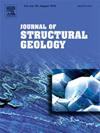Growth of the northeastern Tibetan plateau since the Middle Miocene as revealed by syn-tectonic growth strata
Abstract
Syn-tectonic deposition of sediments (growth strata) preserves a direct record of mountain building-erosion and basin deformation. When and how these sediments incorporated into forward propagating fold-and-thrust (FTB) belts can shed light on the above processes. Despite many years of research, there is still ongoing debate about the timing and mechanisms of the southern Qaidam fold-and-thrust belt in the northeastern Tibetan Plateau. Here, we provide insight into the deformation of the Qaidam Basin and the broader tectonic processes of the northeastern Tibetan Plateau through detailed analysis of the Dafengshan (DFS), Jiandingshan (JDS) and Heiliangzi (HLZ) anticlines along the southern Qaidam FTB. Identification of the growth strata by Area-Depth analysis and age determination indicate that deformation of the DFS anticline initiated in the mid-Miocene (∼15 Ma), and has successively experienced lateral growth (∼15–8.0 Ma) and uplift (∼8.0 Ma-present). This timeline of deformation coincides with periods of mountain building in the northeastern Tibetan Plateau and might be related to the removal of mantle beneath northern Tibet. The synchronization of growth strata with an increase in sedimentation and exhumation rates reveals the reactivation of the tectonic belt around the basin in the mid-Miocene, creating the current basin-range landform; since ∼8 Ma, compression has expanded rapidly into the interior of the Qaidam Basin, leading to incorporation of basin deposits into the FTB. Geomorphological analyses coupled with 3-D fold modeling demonstrate that the JDS and HLZ-fold train with S-shaped configuration is a coherent fold system developed by lateral growth and linkage of two different fold segments in the context of the N–S directional compression of the plateau. Considering the prevalent S-shaped constructions within the basin and the current seismicity, we propose that the dominant structures in the southwestern Qaidam Basin are a series of thrust faults and folds controlled by the compression component of the East Kunlun Fault, with a limited influence from the Altyn Tagh Fault.

 求助内容:
求助内容: 应助结果提醒方式:
应助结果提醒方式:


